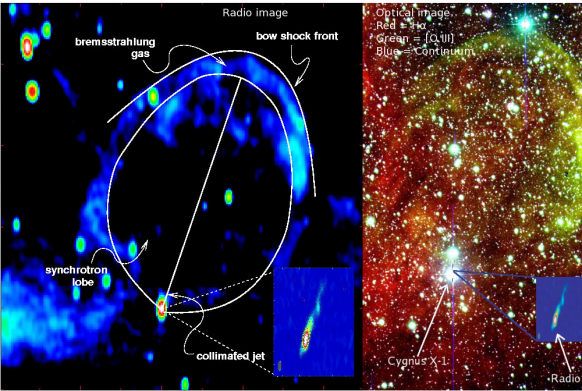How BHB jets energize the ISM
Like AGN, XRBs also energize their local environments via strong, high energy radiation (they are the strongest X-ray sources in the Galaxy) and via kinetic flows: jets and winds. XRBs emit radiation throughout the electromagnetic spectrum, from radio up to X-ray and sometimes γ-ray. Multiwavelength studies are therefore important and indeed required to separate out the emission from various emitting components in the system. However, most XRBs close enough to us for multiwavelength studies are in the plane of our Galaxy, and their ultraviolet (UV) emission is heavily absorbed by gas and dust in our Galaxy (by the so-called interstellar medium–ISM). However, high energy photons can also ionize gas in their local environment. In these regions, UV light and X-rays are absorbed and reprocessed to longer wavelengths. Thus by identifying these ionized regions and measuring their luminosities it is possible to constrain the UV flux of the XRB which is not visible directly.
The classical model for BHBs, the thermal Comptonised corona model, describes the system as a black hole, an accretion disk and a corona. Recently, observations indicate that in some states, the jets from XRBs may account for not just the radio emission but higher energy too (infrared, optical, X-ray). The commonly used corona model does not account for jets, but newer models are beginning to look at how these regions are linked, including the approach by our group. In the models described above, X-rays can come from either direct synchrotron radiation from the jets, or from inverse Compton emission from thermal/nonthermal plasma at the base of the jets (in essence, taking on the role of the corona). In the inverse Compton case, a significant amount of UV from synchrotron radiation in the magnetic jet base/corona is predicted, which is absent in thermal corona models.
Wide-field imaging observations of nebulae ionized by the UV/soft X-ray photons from XRBs, for example in narrowband optical/infrared emission line filters, can in principle constrain the parameters of the energized gas, such as the size, electron density and temperature. Using a radiative transfer code (called CLOUDY; Ferland et al. 1998), we simulate how X-ray and UV radiation of black hole XRBs ionize these environments. From this we hope to place constraints on the amount of UV/soft X-ray light emitted from these systems before the light interacts with the environment. Once we learn how much UV/soft-Xray radiation was initially emitted by the system, then we can finally model the full broadband radio-to-X-ray spectra of XRBs with the most advanced models. This can be important for future studies of e.g. the epoch of re-ionization.
An independent method of measuring the kinetic power contained in the jets is to identify and study sites of jet-ISM interactions. If the jet power and local ISM density are both sufficiently high, jets are thought to push away the gas, inflating a bubble containing synchrotron plasma with a shock wave at its edge. These structures are rare but sometimes visible at radio and optical wavelengths (see images of Cygnus X-1). They are analogous to the famous radio lobes of AGN, and can be used as bolometers to infer the time-averaged jet power of the XRB. Our group is in the process of identifying candidate interaction sites and studying their energetics. These nebulae may provide the tightest constraints on the time-averaged power of XRB jets, which can then be compared to those of AGN.

